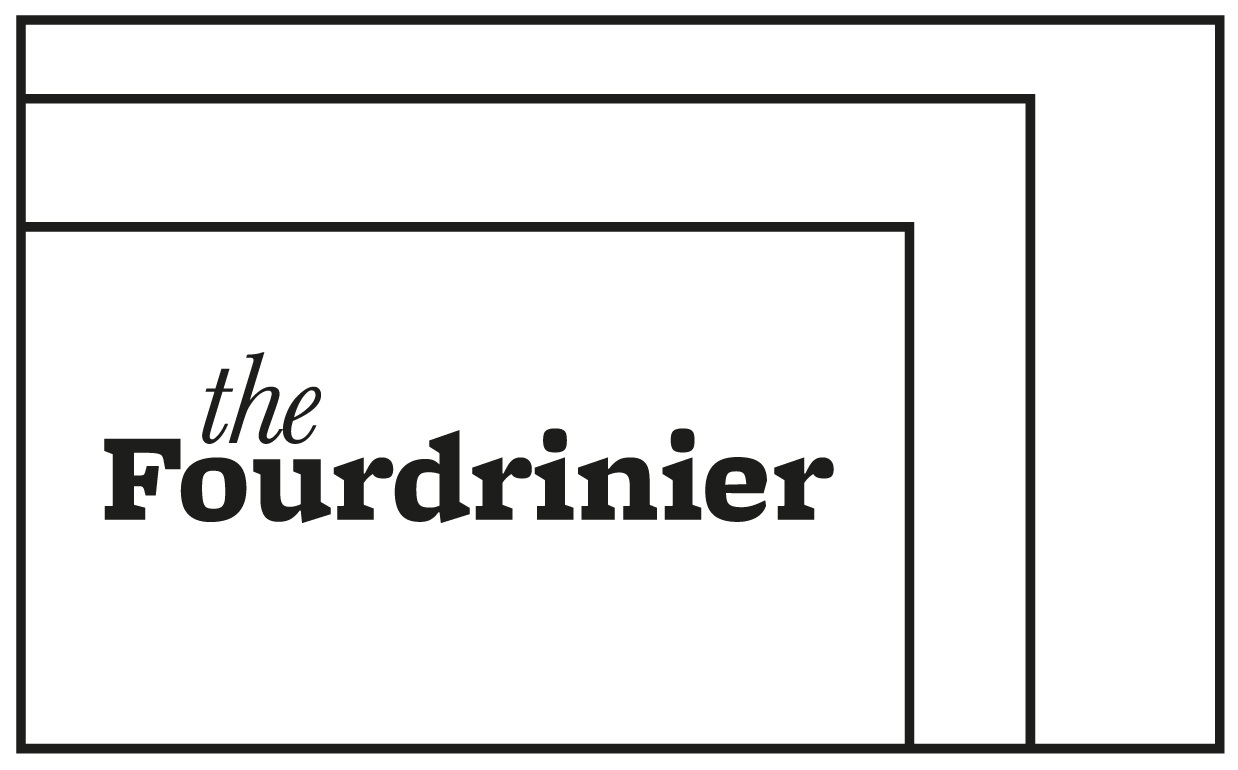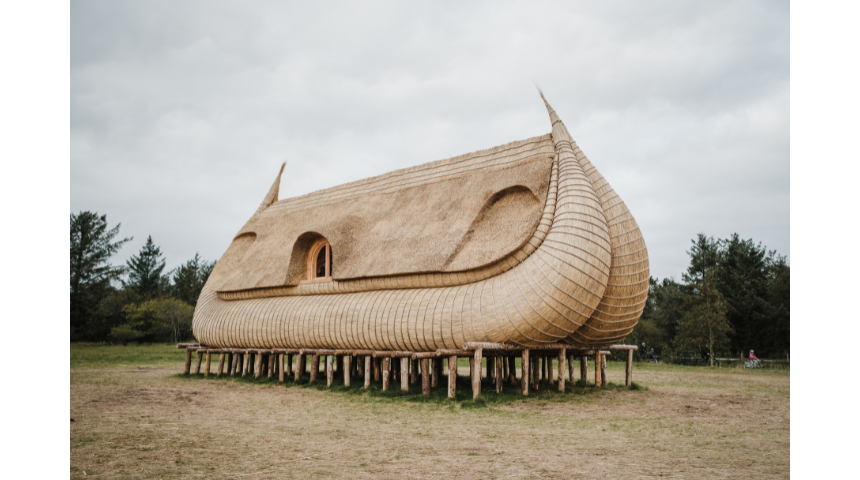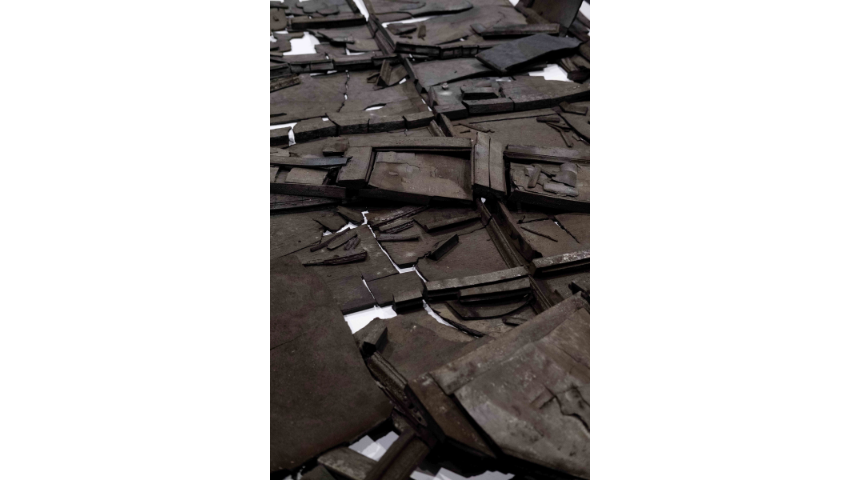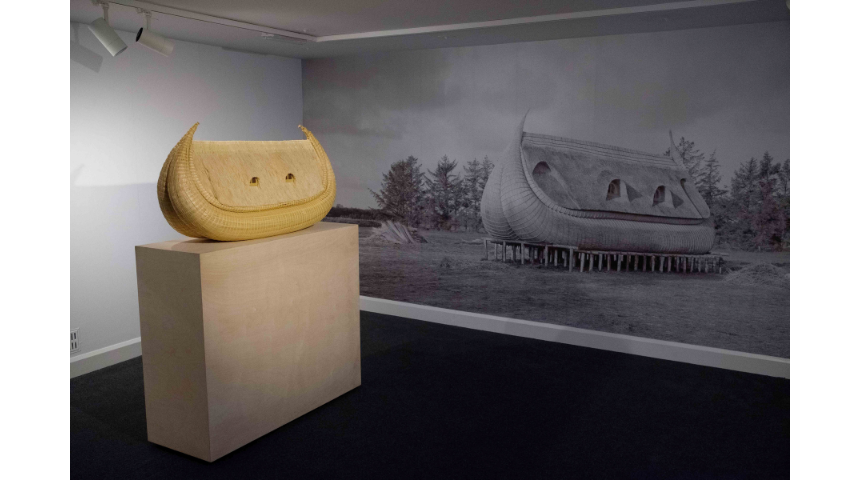REVIEW Oct 2025 The Righting Moment – ‘Simon Starling: Boat Works’ at Abbot Hall & Windermere Jetty Museum
Jo Manby
Simon Starling Houseboat for Ho (2023) Miscanthus 500 x 1100 x 450 cm approx. Courtesy of the Artist and The Modern Institute/ Toby Webster Ltd., Glasgow Photo: Simon Starling
Lakeland Arts presents ‘Simon Starling: Boat Works’ in two concurrent exhibitions, one filling the first floor of Abbot Hall Art Gallery in Kendal, the other occupying indoor and outdoor space at Windermere Jetty Museum. the Fourdrinier editor Jo Manby visited the shows and had the opportunity to talk with Simon Starling about the thought processes, inspirations and ideas behind his work, from his fondness for the ‘use and abuse of boats’ to his gentle satire of the state of the UK’s nuclear deterrent to migration, transformation and climate change. Born in Surrey and now based in Copenhagen, Denmark, Starling won the Turner Prize in 2005, presented work at the 50th and 53rd Venice Biennales and has exhibited internationally. ‘Boat Works’ is on view with gallery admission until 13 March 2026.
In the final chapter of Nobel prize winning author, William Golding’s novel The Inheritors (1955)(1), Tuami, the grief-stricken leader of a besieged group of Neanderthals escaping a murderous new line of humans, steers a slow boat towards open plains and away from the so-perceived malevolent mountains. Golding pictures the boat as a dark point between the blazing sky and water of a new dawn in an allegory of incomprehension.
There’s something about the way Simon Starling harnesses the ancient tragi-comedy whereby the sheer absurdity of human life (born unable to walk, having to learn how to eat, 100 ways to die at the end and a big question mark, is there anything else beyond?) can be easily summoned by the juxtaposition of intense labour and varyingly futile results. In Autoxylopyrocycloboros (2006), the ‘protagonist’ / artist literally saws up and combusts, in a log burning steam engine, parts of the vessel he is sailing in, as he goes along. Starling comes across as a mild-mannered, thoughtful person, but here is an image of someone laughing in the face of death and burning with humanity. Also, someone who probably watched a lot of Tom and Jerry cartoons as a child.
Starling’s works often have the weight and impact of an epic novel. Entering Gallery 5 of ‘Simon Starling: Boat Works’ at Abbot Hall, his 2023-24 work Houseboat for Ho: Presented by the Strawman is represented by a scale model of a reed boat that Starling built with a team of collaborators. He had been commissioned by the Danish Arts Foundation to create an artwork for the village of Ho in the Wadden Sea National Park, positioned on the south west coast of the Jutland peninsula, Denmark. The brief requested that the artist encompass the fact that Ho has an uncertain future due to climate change-induced flooding. The model, with its Cheshire cat smile, stands on a single plinth in the gallery, commanding a strange, inscrutable presence. Behind it is an inkjet printed vinyl wallpaper mural of a monochrome photograph of the IRL houseboat, standing in a field on its oddly millipede-like stanchions. These, Starling later explained, were formed so that rope could be passed underneath the boat during the construction process.
At first glance, you could be looking at a photograph from the turn of the last century taken by an anthropologist observing an indigenous community. Starling collaborated with the Arratia-Esteban family of reed boatbuilders from Bolivia, whom he brought over to work with local Jutland thatchers Bjarne Johansen and Jeff Brankley to construct the 11-metre-long houseboat from wood and plaited bundles of reeds. To the right is a two-dimensional framed work, The Strawman, a charcoal drawing of a skeletal model of a marooned sailor crossed with the artist’s self-portrait made from the same straw that was used to build the houseboat.
Houseboat for Ho is inspired by Norwegian writer and explorer Thor Heyerdahl’s ‘Ra II’ expedition of 1970 when he sailed from the west coast of Africa to Barbados in a papyrus reed boat. Heyerdahl wrote the controversial but highly popular book, ‘The Kon-Tiki Expedition: By Raft Across the South Seas’, which sold out in 15 days when it was first published in 1948. For this voyage, Heyerdahl sailed from South America to the Polynesian Islands for 101 days over 6900km on a balsa tree raft. Heyerdahl was labouring under the illusion that the original inhabitants of Easter Island were the ‘Tiki people’, a race of ‘white bearded men’ (with blue eyes and fair or red hair) whom he claimed originally sailed from Peru, and that a branch of these people became the rulers of the Inca Empire and set out to voyage in the Pacific Ocean under the leadership of Con Tiki Viracocha.
I asked Starling what he thought of the fact that Heyerdahl’s premise for the Kon-Tiki Expedition was deemed pseudo-scientific and racially controversial even before he set out. ‘In a way I don’t care. I love Thor Heyerdahl as a storyteller. Its veracity as hard science [or not] is perhaps why it’s extra special. There’s a comedy to it in a way. He was a really persuasive storyteller. The books funded the madcap adventures.’ Starling looks fondly back on the process of making the reed houseboat. ‘One of the great pleasures was to build it in public – so the site was open to people’s stories, their relationship to the place.’ Someone who had been to Lake Titicaca turned up, someone else who’d brought a model boat signed by the boat builder’s grandfather, who’d helped Heyerdahl build his reed boat. There was even an anthropologist who had studied reed-based culture on the Tigris and the Euphrates rivers and had ‘volumes of information’ about the Marsh Arabs. Starling kept a journal of the process of making Houseboat for Ho (available to buy at Abbot Hall and Windermere Jetty Museum).
Starling’s projects remind me of Werner Herzog’s celebrated film, Fitzcarraldo in the fine line they tread between epic volumes of labour, heroic pointlessness and a kind of shamanic power that acknowledges human absurdity. Does this come naturally to him as an artist? There’s a pause, and then Starling says, ‘It’s a film that I love…’ but then points me in the direction of Les Blank’s documentary The Burden of Dreams in which he interviews Herzog in the jungle about the making of the film. ‘The making is the driving force behind the work. I almost prefer the documentary,’ says Starling. ‘Fitzcarraldo the film is a bit too full of hyperbole. The doc gets to the crux of the matter.’
Simon Starling Houseboat for Ho (2023) Miscanthus 500 x 1100 x 450 cm approx Courtesy of the Artist and The Modern Institute/ Toby Webster Ltd., Glasgow Photo: Simon Starling
Then I ask if he is amused and exasperated by humanity in equal measure. ‘Fair comment!’ says Starling. ‘I have found comedy, or humour, a very useful tool. It creates space for an audience to occupy, gives room to move in the work. If you come head-on with something polemical it’s a bit unnerving, but comedy can diffuse.’ Starling talks about the Autoxylopyrocycloboros work, on show in Gallery 7 in the form of a slide show of 38 colour transparencies, a four-hour entropic voyage across Loch Long in Scotland fuelled by burning wood cut from the boat itself. This particular loch is the ‘birthplace of the steamship, and home to its distant cousin, Trident, the increasingly decrepit, steam-powered nuclear submarines.’ (2) ‘Addressing the nuclear deterrent – it’s oddly abstract and hard to engage with’, Starling reflects. Taking a comic approach seems to hit home, but again, it’s epic – the epitome of a voyage of self-destruction, an example of marine nihilism.
I asked Starling how he gets into the zone, whether it’s through quiet reflection, sketching, conversation or research, or a combination. He finds travelling good for generating ideas. It’s ‘the in-between spaces where ideas emerge – say, between the studio and a site. You’re a bit abstracted from the everyday, a bit displaced.’ Laughing, he adds ‘I don’t have a special place where I go for ideas. In a way the practice is about connecting things that haven’t been connected before, a distillation process. I often look at old work and can’t quite recall where the initial spark came from. The work has its own momentum. The best work tends to make itself. You are just an antenna to receive and patch together the signals.’ Not in a particularly spiritual sense, he adds. Almost an ongoing flowing narrative I suggest, that you can dip in and out of.
I wondered what proportion of Starling’s process in creating his work is spent in pure cogitation or philosophical speculation or conceptualizing what he is going to do. Of course, it’s hard to generalize. ‘In some ways each work develops in its own particular, idiosyncratic way. So, there’s no methodology for it,’ says Starling. ‘There’s two ways that things can evolve. Sometimes I will have a half-formed idea in the abstract that you carry around with you and often you arrive in a particular context or landscape or building or ecological situation and that half-formed idea finds a home.’ The other way is when a commission or set of parameters presents itself. Houseboat for Ho came out of an invitation to visit Ho and ‘find out about the lie of the land, think about the future of the place.’ Starling describes slowly developing an idea and the idea having a relationship to previous projects. ‘The Mahogany Pavilion is a precursor to the houseboat project,’ he explains.
The Mahogany Pavilion (Mobile Architecture No.1) (2004) played with the idea of a two-fold inversion in the counterpointing of links between architecture and boat building. Starling literally inverted a ‘Loch Long’ racing yacht built in Scotland in the 1960s and, simultaneously, a journey, that of the original portage of mahogany from South America to Europe that was used to build the boat in the first place. The boat is transformed into a ‘makeshift canopy or pavilion’, and is now housed permanently at the Inhotim Institute at Belo Horizonte, Brazil, where it stands balanced on the tip of its mast amidst a grove of mahogany trees. This project is represented by archive material in one of two vitrines in the exhibition (in Gallery 5) which document the making of many of Starling’s works not physically present. Also in Vitrine 1 is, among other projects, documentation of The Expedition (2011), a puppet play Starling wrote and staged, which follows ‘a hapless adventurer – a self-portrait of sorts – as he attempts to get to New York by boat, a journey… beset by calamities.’ The work is based on four previous projects, ‘each of which involve the use and abuse of boats’ and which, in The Expedition, ‘are combined into a single slapstick narrative.’
Simon Starling Boat Works installation shot Blue Boat Black Photo Credit: Liam Collins
In Vitrine 2, materials pertaining to Shedboatshed (Mobile Architecture No.2) (2005) made the following year are included, the work that Starling won the Turner Prize with. The project was devised in response to an invitation to exhibit in a show called ‘Cuttings’ in Basel, Switzerland. Starling found an old wooden shed in Schweizerhalle and moved it 8km downstream to Basel via ‘the temporary mutation of the shed into a boat’. Only wood from the boat was used, and any excess wood was transported in the boat itself. The traditional oar used to row the boat had originally been displayed on the shed as decoration. On arrival at the Museum für Gegenwartskunst, the boat was dismantled and reconstructed into the shed. Displayed in the vitrine are photographs of the shed and the boat, technical drawings and a tiny cardboard model of the boat, scored and folded through a boat builder’s lofting process.
Moving into Gallery 6, Blue Boat Black (1997) comprises the charred remains of a boat, reminiscent of a museum display of a primitive vessel exhumed from a peat bog, laid out on a large dais-like plinth along with tools, fishing tackle, a cool box, aluminium trestles, a life jacket and assorted clothing and shoes. A handpainted, serifed text installation lists the French names of fish: ‘deux dorades’, ‘une brème de mer’, ‘deux rougets’, ‘un pageot’. The project appears effortless and somewhat meandering. Starling came across a disused wooden vitrine at Chamber Street Museum in Edinburgh. Undertaking a residency in Marseille, he broke the case down in Scotland, flatpacked it and drove to Marseille with it strapped to a roof rack. On arrival, he made it into a boat and went fishing, caught some fish and cooked the fish. To cook the catch he made the boat into charcoal, with a local charbonnier. He recalls how the charcoal burner refused to entertain putting the dismantled boat parts into his kiln before Starling had spent several days scraping off the paint so it wouldn’t contaminate future burns. Finally, the vitrine came full circle as Starling returned the carbonized remains of the boat to the museum orbit, exhibiting it as a complete work. I asked Starling, was he making it up as he went along? Did he only decide once he got to Marseille to go fishing and then cook the fish over the embers of the burning boat? ‘No, it was preplanned, almost as soon as I found the vitrine. That was an example of a half-formed idea at the beginning that coalesced when I came across the wooden display case.’
Represented by an 18-minute-long film viewable in Gallery 7, Project for a Rift Valley Crossing (2015-2017) consisted of a canoe built with magnesium extracted from Dead Sea water and used on the 30 November 2016 in an attempted crossing of the Dead Sea from Israel to Jordan. Starling’s brother-in-law told him about a British aeronautical engineer, Frank Kirk, building lightweight bicycle frames from magnesium produced from seawater. Starling’s archetypical reaction, ‘the logical next step in the chain of thought triggered by this tale of ingenuity was to build, not a bike, but a boat from seawater and to use it to cross the sea from which it was made.’ Not only were the process of magnesium extraction and the fabrication of the boat highly complex, but the project also entailed ‘a complex cocktail of negotiation and diplomacy’ requiring the cooperation of both the Jordanian and the Israeli authorities. However, as Starling explains, it was the approach of a storm that meant the voyage had to be curtailed, rather than geopolitics.
How did Starling go about processing the magnesium for Project for a Rift Valley Crossing? ‘Basically, the list of credits is almost as long as the film itself. I had the idea,’ Starling explains, ‘of making it even longer – of including the people who built the camera and who made the clothes. But I found a reluctance in the companies to reveal the identity of the people who worked for them.’ As he says, the list of people involved in making all the multiple components of a camera would be miles long. As it is, it includes everyone from welders and drone handlers to cinematic technicians and musicians.
Simon Starling Project for a Rift Valley Crossing A canoe built to cross the Dead Sea Rift between Israel and Jordan using 90 kg of magnesium produced from 1900 litres of Dead Sea water (2015-16) Production still Dead Sea, 2016 Courtesy of The Artist and The Modern Institute/Toby Webster Ltd, Glasgow Photo: Simon Starling
The processing of magnesium (from highly saline seawater) began with a conversation with the chemistry department at Nottingham University; and there was a foundry in Germany who produce lightweight components for racing cars and speedboats, and they agreed to make the parts for Starling’s project. ‘I’ve always tried to make my collaborators the subject of my work.’ Each project is like a constellation of things but it has to have a gravitational centre to hold it in orbit. Conceptually the projects are neat and to the point – here, the magnesium boat is rowed by two men and filmed from above by a drone, so that the boat mimics a small fish or floating seed pod shape amidst the salty jade green Dead Sea – but philosophically they are open-ended and pluralistic.
Island for Weeds (2003) occupies Gallery 8, formed of an imposing, approximately 6 x 4 metre oval metal slab covered in a layer of earth, stones and vegetation, which rests on blue and yellow flotation cylinders made of the type of vinyl pipe used for gas and water mains. Starling represented Scotland in the 2003 50th Venice Biennale with this work. In it, he references contradictory attitudes to Rhododendron plants, first introduced to the UK as an exotic species and admired for their luxurious blossoms, but which have become a problem for landowners and nature conservationists. Here the plants can run rampant over their own land but remain containable. Metaphorically, again, William Golding flits into view, with his island of stranded, chaotic schoolboys in Lord of the Flies (1954).
Coming away from Abbot Hall and heading for Windermere Jetty Museum, I take a bus to Bowness, walk out of the town to Lake Windermere in a rainstorm. The museum is fitted out with an oxidized copper exterior and huge plate glass windows. Designed by Carmody Groarke working with engineers Arup, it acts as a threshold between the land and the lake with a dock built into the museum space, which in turn houses at least 40 boats. As one enters the dock area, a large scale drawing takes up a significant area of the wooden partition at the other side, viewable between the dusty plum-coloured sail of one yacht and the white net sail of another. The Po River (From the Cottian Alps to the Adriatic) / An Ongoing Boat Work (2025) is an inkjet plotted print on self-adhesive paper inspired by a shocking vision of Northern Italy’s 2022 drought, when the bed of the Po River was ‘reduced in places to a sinuous trickle’. Starling aims to undertake a journey from the source of the Po in the Cottian Alps to the river mouth on the Adriatic in an amphibious bicycle-boat, constructed and tested with the conservation boat-building team at Windermere Jetty Museum.
‘In a way it was an attempt to bring the new project into the exhibition. Working with the conservation team was one of the attractions of the show for me. It was the deciding factor. While it’s unusual to present a work prior to its making, it’s a way of building momentum. Normally it’s just there in my head. It’s quite nice for boat builders and public (and me) to have a sense of it. It might end up something different’. The conservators worked out the lofting process from the coloured plotted drawing on show at The Jetty Museum. ‘The length of the floats, how they would affect speed. Stephen [one of the conservation team] came up with a beautiful equation.’
Talking about journeys, voyages and narratives, Starling observes of himself that he is involved more and more in writing. ‘I became an artist to avoid language,’ he says. ‘It was my worst nightmare to stand up and read in front of class. But now I’ve got so much work out there that I find myself trying to retell some of that history.’ He has a noticeboard covered in text and photos, trying to decide what a website about his work would or should look like, and it’s a daunting task. I ask Starling what he would like to happen to his archive, say 100 years from now. One problem is ‘the archive is both material and digital – trying to get them into a stable relationship with each other is difficult.’ I wondered if he had ever been approached by a filmmaker wishing to option one of his projects. ‘I need a Les Blank – a documentary maker, perhaps!’ says Starling. The project he made in 2016 At Twilight, inspired by W B Yeats’s 1916 play At the Hawk’s Well (which in turn combined Irish folklore and Japanese Noh theatre), and on which he worked with director Graham Eatough, commissioned by The Common Guild in Glasgow, was made into a short documentary film. ‘I like the idea that there’s not just one fixed form. As images, as stories – film is a liberating way to think about them.’
Simon Starling Boat Works installation shot Houseboat For Ho Photo Credit: Liam Collins
A boat enables exploration as well as being a refuge and escape, but can also be a watery grave and a deathtrap. On a daily basis we hear news of desperate people cast adrift on unseaworthy vessels only to drown a few miles from shore. In our war-torn times, hearing fireworks at night, there’s always a fraction of a second where I wonder if one day it might be a bombing campaign. Looking back at the decade Starling was born, the 1960s, the end of WWII had been a matter of 15 years or so. Not so far distant a thought. On the Glasgow Central train heading north to visit ‘Boat Works’, the landscape is wreathed in low cloud, the white sky occluded by sheet rain. On the way back, it’s still raining and I can sense the metaphorical tilt of the earth on its axis, the tension between earth and sea tipping, water encroaching on the land. Art might not be the thing that saves us per se, but it can aid sea change and cause paradigm shifts if enough people engage with open hearts and minds.
Footnotes
(1) William Golding The Inheritors (first published 25 September 1963) Mariner Books, an imprint of HarperCollins Publishers (US)
(2) The Modern Institute https://www.themoderninstitute.com/artists/simon-starling/works/autoxylopyrocycloboros-2006/72/
This review is supported by Lakeland Arts






